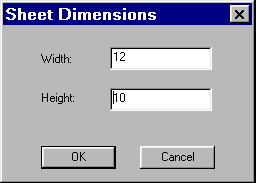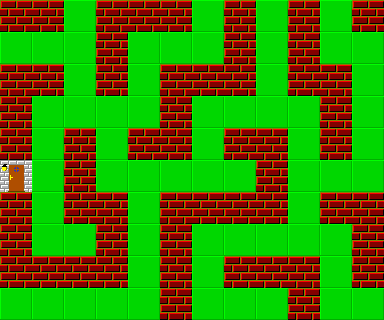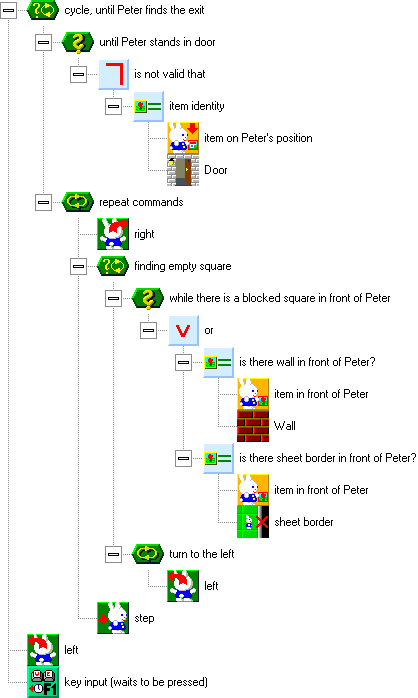8. Peter Walks on Marks <<< Contents >>> 10. Keyboard Control
Peter has wandered into a large maze. He cannot find his way out, and we have to help him.
We will start by creating a new program. In
the program window, click the New ![]() button. Type Way as the program name.
button. Type Way as the program name.
In the Global Variables and Functions window, we will prepare two items for the maze
— a wall and a door. We could draw them, but we may use the
items that are already prepared in the item library. The library
is in the bottom right window called Library of Variables and Functions. There are data elements like number, item, or
picture in it. Expand the item
element, and in the [examples] groups, Cottage subgroup, find the elements labeled Door ![]() and Wall
and Wall ![]() . Drag
them into the Global
Variables and Functions
window. This is a quick and easy way to create new items, which
have already been named and drawn.
. Drag
them into the Global
Variables and Functions
window. This is a quick and easy way to create new items, which
have already been named and drawn.
Now we will create the maze sheet.
Double-click the sheet ![]() element. We will make the sheet smaller, so that the maze does
not have to be too big. Click the Dimensions
element. We will make the sheet smaller, so that the maze does
not have to be too big. Click the Dimensions
![]() button. A window
for specifying sheet dimensions appears. Type 12 as the width and 10 as the
height.
button. A window
for specifying sheet dimensions appears. Type 12 as the width and 10 as the
height.

Use the Door and Wall elements to create the following maze:

The program will be based on a conditional repeating of
commands ![]() . We want Peter to
repeat his steps around the maze until he finds the door. In the
cycle condition, we will use the item on Peter's position
. We want Peter to
repeat his steps around the maze until he finds the door. In the
cycle condition, we will use the item on Peter's position ![]() element. It is similar to the item in front of Peter element, but it applies to the square, on which
Peter is standing. It can be found in the Peter - extension
element. It is similar to the item in front of Peter element, but it applies to the square, on which
Peter is standing. It can be found in the Peter - extension ![]() group.
group.
The cycle condition could be expressed like
this: "If it is not true that
the item on Peter’s position is the door, repeat…"
The word not tells us that we need the opposite
of the item identity test. For this, we have an element called is not valid that ![]() .
The element is called logical
negation, and its function is
to invert the result of the comparison from true to false, and from false to true. It is located in the calculations
.
The element is called logical
negation, and its function is
to invert the result of the comparison from true to false, and from false to true. It is located in the calculations ![]() group, logic
operations
group, logic
operations ![]() subgroup.
subgroup.
First, we will place the is not valid that ![]() element into the
while is valid
element into the
while is valid ![]() cycle condition. We
will attach the item
identity
cycle condition. We
will attach the item
identity ![]() element, and insert
the item on
Peter's position
element, and insert
the item on
Peter's position ![]() and Door
and Door ![]() elements into it.
elements into it.
In the cycle body, we will ensure that when
walking around the maze, Peter will stick to the border on his
right. In the beginning of the cycle, we will tell Peter to turn
right by using the right ![]() command. The following command will be a conditional repeating of
commands
command. The following command will be a conditional repeating of
commands ![]() cycle. This will tell
Peter to turn to the left, until he will find a square onto which
he can go. For this, we will use the left
cycle. This will tell
Peter to turn to the left, until he will find a square onto which
he can go. For this, we will use the left ![]() command.
command.
In the second (inner) cycle, we will test
if there is a blocked square in front of Peter, i.e. if he should
turn further to the left. The first blocked square is the Wall ![]() . Peter
also cannot go through the border of the sheet. This can be
tested by a special element called sheet border
. Peter
also cannot go through the border of the sheet. This can be
tested by a special element called sheet border ![]() (located in the sheet
(located in the sheet ![]() group). It is special by the fact that it is not a data variable,
but a constant, and so you cannot edit it. Its value can be kept
in variables and tested, but it cannot be viewed by putting it on
the sheet.
group). It is special by the fact that it is not a data variable,
but a constant, and so you cannot edit it. Its value can be kept
in variables and tested, but it cannot be viewed by putting it on
the sheet.
We have two tests of items in front of
Peter, and we need to express this: "As long as there is
a wall or a sheet border in front of
Peter, repeat left." The word or is a
logical element again — or ![]() , and it is called logical sum. It is located in the calculations
, and it is called logical sum. It is located in the calculations ![]() group, logic
operations
group, logic
operations ![]() subgroup. We will
insert the or element into the cycle condition and add two
comparisons of items in front of Peter, with the wall and the
border.
subgroup. We will
insert the or element into the cycle condition and add two
comparisons of items in front of Peter, with the wall and the
border.
Peter is facing an empty square now, so we
have to add one last element into the main cycle — step ![]() .
This tells Peter to go to the empty square.
.
This tells Peter to go to the empty square.
Finally, we will tell Peter that when he
finds the door, he should turn towards us and wait untill we
press a key. Behind the main cycle, add the left ![]() and
key input
(waits to be pressed)
and
key input
(waits to be pressed) ![]() elements. The
resulting program is shown here:
elements. The
resulting program is shown here:

Run the program. Peter walks around the maze, until he finds the exit. It is just behind the corner on the left side, but he does not know it and tries to find the exit from the right, so it takes some time.
Let us replace the left ![]() and
right
and
right ![]() elements. This changes Peter’s search method, so that he
will stick to the wall on his left. In our maze, he finds the
exit much sooner.
elements. This changes Peter’s search method, so that he
will stick to the wall on his left. In our maze, he finds the
exit much sooner.
8. Peter Walks on Marks <<< Contents >>> 10. Keyboard Control